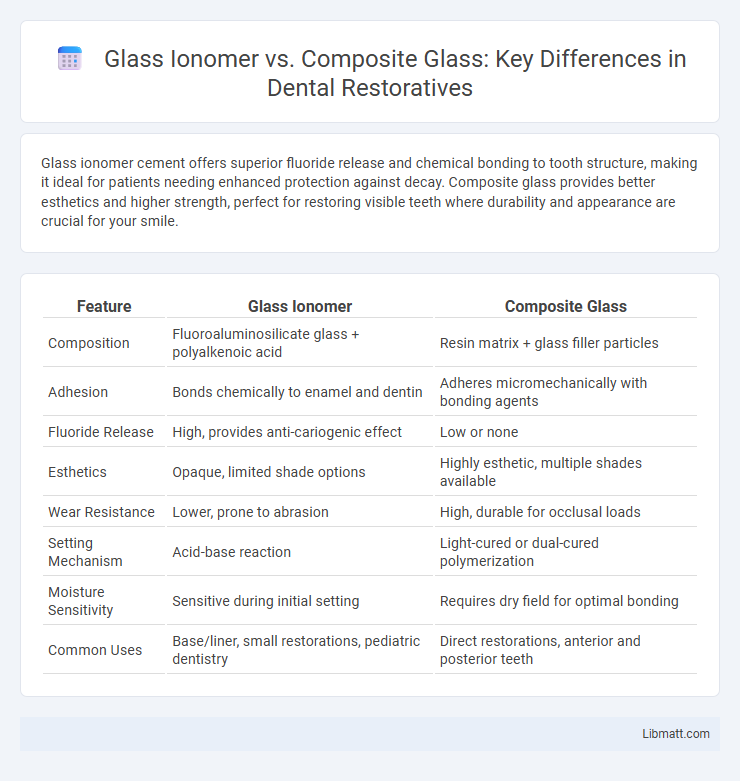Glass ionomer cement offers superior fluoride release and chemical bonding to tooth structure, making it ideal for patients needing enhanced protection against decay. Composite glass provides better esthetics and higher strength, perfect for restoring visible teeth where durability and appearance are crucial for your smile.
Table of Comparison
| Feature | Glass Ionomer | Composite Glass |
|---|---|---|
| Composition | Fluoroaluminosilicate glass + polyalkenoic acid | Resin matrix + glass filler particles |
| Adhesion | Bonds chemically to enamel and dentin | Adheres micromechanically with bonding agents |
| Fluoride Release | High, provides anti-cariogenic effect | Low or none |
| Esthetics | Opaque, limited shade options | Highly esthetic, multiple shades available |
| Wear Resistance | Lower, prone to abrasion | High, durable for occlusal loads |
| Setting Mechanism | Acid-base reaction | Light-cured or dual-cured polymerization |
| Moisture Sensitivity | Sensitive during initial setting | Requires dry field for optimal bonding |
| Common Uses | Base/liner, small restorations, pediatric dentistry | Direct restorations, anterior and posterior teeth |
Introduction to Dental Restorative Materials
Glass ionomer and composite resin are two primary dental restorative materials used to repair tooth structure. Glass ionomer releases fluoride, which helps prevent recurrent decay and chemically bonds to tooth enamel and dentin, while composite resins provide superior esthetics and increased strength due to their resin matrix and filler particles. Both materials have specific applications, with glass ionomer favored for cervical lesions and pediatric restorations, and composite resins preferred for load-bearing and anterior restorations.
Overview of Glass Ionomer Cement
Glass ionomer cement (GIC) is a dental restorative material known for its chemical bonding to tooth enamel and dentin, releasing fluoride to help prevent decay. It offers biocompatibility and is commonly used in cervical lesions, root caries, and as a luting agent, contrasting with composite resins that emphasize aesthetics and strength. Your choice between GIC and composite glass should consider factors like adhesion, fluoride release, and the clinical application site.
Overview of Composite Glass Materials
Composite glass materials, primarily composed of resin-based matrices combined with inorganic glass fillers, offer enhanced aesthetic qualities and superior mechanical strength compared to traditional glass ionomer cements. These composites provide excellent wear resistance, high polish retention, and color stability, making them ideal for anterior and posterior dental restorations. Innovations in filler technology and resin chemistry continue to improve the translucency and durability of composite glass materials, promoting their widespread use in restorative dentistry.
Composition and Structure Differences
Glass ionomer cement consists primarily of fluoroaluminosilicate glass and polyacrylic acid, forming an acid-base reaction matrix that releases fluoride ions, enhancing its bioactivity and adhesion to dentin. Composite resin is composed of a methacrylate-based organic matrix reinforced with inorganic filler particles such as silica or glass, allowing superior esthetics and mechanical strength due to polymerization. The unique chemical bonding in glass ionomers contrasts with the micromechanical retention in composites, resulting in distinct differences in durability, fluoride release, and biocompatibility.
Handling and Application Techniques
Glass ionomer offers easy handling with its self-adhesive properties and chemical bonding to dentin, making it ideal for quick, moisture-tolerant restorations. Composite glass requires meticulous layering and light curing, demanding precise application techniques to avoid voids and ensure optimal bond strength. Both materials necessitate specific clinical skills, but glass ionomer provides a more forgiving application process in moisture-prone environments.
Bonding Strength and Adhesion Properties
Glass ionomer exhibits strong chemical bonding to tooth enamel and dentin through ionic bonds, providing excellent adhesion, especially in moist environments. Composite glass relies on micromechanical retention and resin-based bonding agents, offering superior bond strength in dry conditions but requiring a well-isolated field for optimal adhesion. Your choice between these materials should consider the clinical situation, as glass ionomer performs reliably with minimal preparation, while composite delivers enhanced strength and esthetics under controlled moisture conditions.
Esthetics: Color and Translucency Comparison
Glass ionomer restorations exhibit less translucency and a limited range of shades, resulting in a more opaque and less natural appearance compared to composite glass materials. Composite glass offers superior esthetics with a wider variety of color options and better translucency that closely mimics natural tooth enamel. Your choice for esthetic dental restorations will benefit from composite glass for more seamless, lifelike results.
Longevity and Wear Resistance
Glass ionomer materials exhibit moderate longevity with wear resistance suitable for low-stress dental restorations, often lasting 5-7 years before replacement. Composite glass restorations demonstrate superior wear resistance and durability, commonly maintaining integrity for 7-10 years or longer under typical occlusal forces. The enhanced mechanical properties of composites make them preferable for high-stress areas demanding extended longevity.
Clinical Indications and Best Uses
Glass ionomer is ideal for restoring non-load-bearing areas, such as root caries and pediatric teeth, due to its fluoride release and chemical bonding to tooth structure, which helps prevent recurrent decay. Composite glass excels in aesthetic restorations for anterior and posterior teeth where durability and excellent polishability are crucial, making it suitable for load-bearing restorations and visible surfaces. Choosing between the two depends on the clinical indication, with your decision guided by the need for fluoride release, esthetics, and mechanical strength.
Cost-effectiveness and Accessibility
Glass ionomer restoratives generally offer superior cost-effectiveness due to lower material costs and simpler application procedures, making them more accessible for public health settings and underserved populations. Composite glass materials, while often more expensive, provide enhanced aesthetic qualities and durability, resulting in longer-lasting restorations but higher initial investment. Accessibility to composite glass may be limited in low-resource environments, whereas glass ionomer cements are widely available and preferred for their fluoride release and ease of use.
glass ionomer vs composite glass Infographic

 libmatt.com
libmatt.com